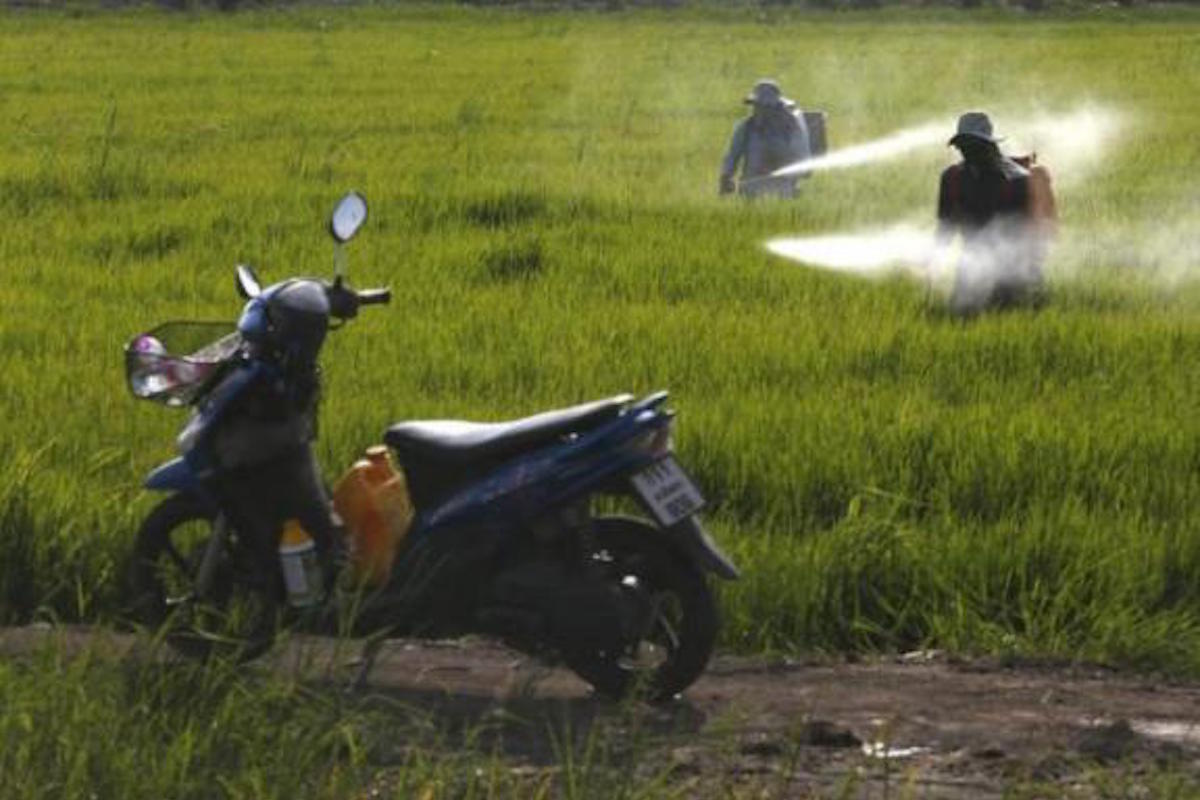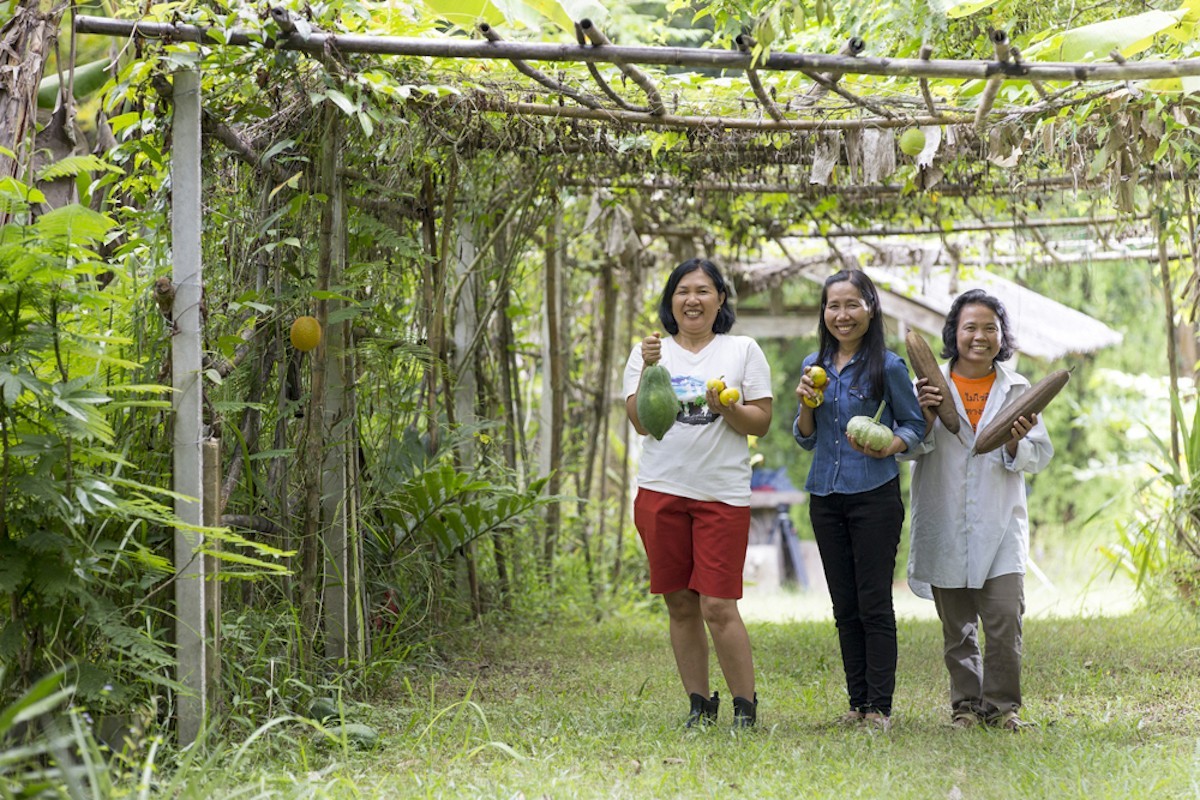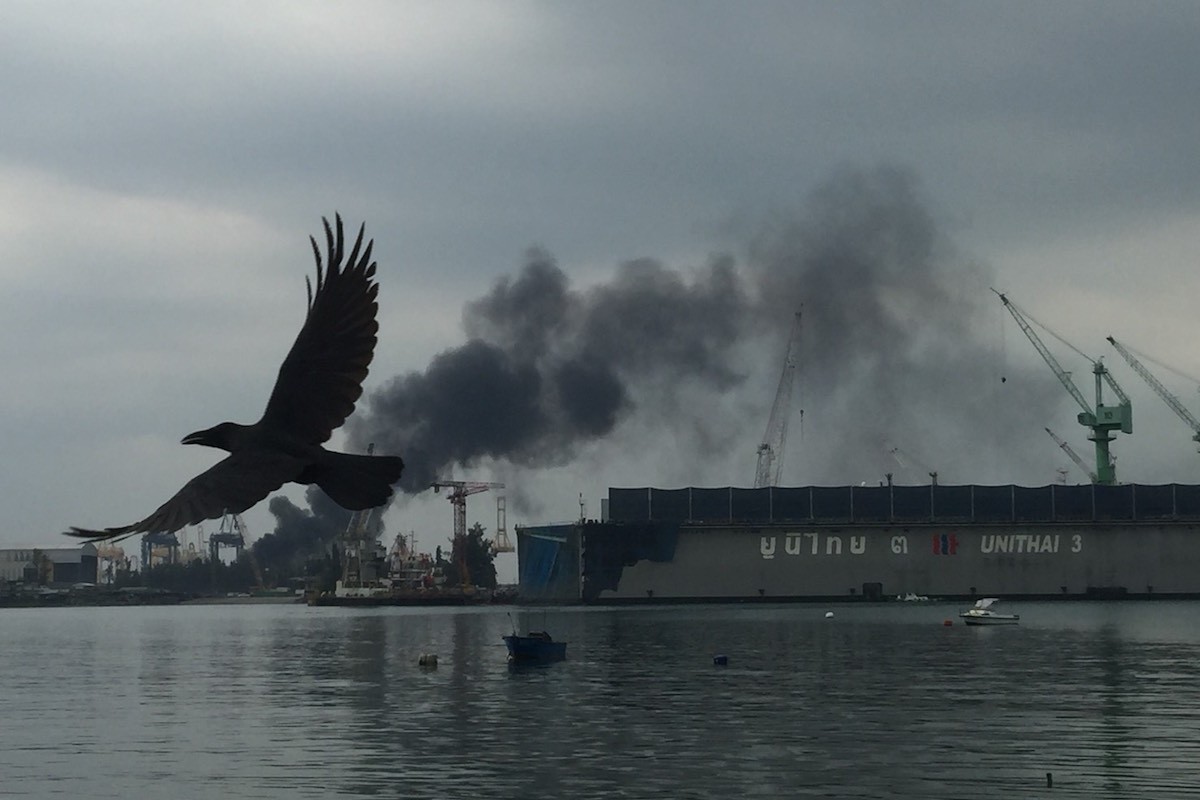This story was produced through a collaboration between Mekong Eye and the Bangkok Post.
Heading down a dirt road, Khampan Suprom zigzags her motorcycle through the grove, passing a small reservoir and plantation on the way. She comes to park under some trees. Dressed in her gardening apron and rain boots, she dismounts and drifts towards her vegetable garden.
One side of the patch grows broccoli, cabbage and melientha. Covering has been placed over the lettuce to shield it from feasting insects. Some fruit trees stand in the corner. Ms Khampan selects her plants based on local market demands.
“These cowpeas could be picked up in the next couple of days,” she said, inspecting the plant’s pods.

It is easy to forget that her idyllic farm plot is located in the middle of Thailand’s industralised east — the region home to the Eastern Seaboard Development (ESD), the country’s first special economic zone. Since launching in the 1980s, the ESD has turned eastern Thailand into a manufacturing and petrochemical hub, with the goal of establishing an export-dependent economy. It remains a major generator of national revenue to this day.
Ms Khampan is a core member of a women-led organic farmers group in the Sanam Chai Khet district of Chachoengsao. The group meets regularly at their office space to share ideas and personal stories about their trade, while working together to market their farm products. They take turns selling their products in local and Bangkok markets every week, with the goal of expanding their client base.

The women are the main economic drivers of their community, leading food production and financially supporting their families. However, reflecting on the Thai economy’s booming years of the ’80s and ’90s brings back memories of a less empowered time.
Shortly after the ESD was founded, the Thai economy reached its highest point of growth as GDP peaked at a 13.3% growth rate in 1988, averaging out to 7% in the proceeding years. The country was deemed an “emerging tiger” of Asia, as well as the “Detroit of Southeast Asia” for becoming the largest vehicle producer in the Southeast Asian region.
However, not everyone enjoyed the benefits of these developments.
In Sanam Chai Khet, investors and land speculators arrived en masse, seeking to persuade farmers to sell land to make way for ESD projects.
Once these properties were sold off, long-time locals were prohibited from collecting any food grown in the wild, as well accessing water sources once freely enjoyed. Some families had to rent their own land from private owners to continue their reliance on farming for survival.
Women were forced to shift roles from being home-based food producers to factory workers. They flocked to factories in pursuit of more secure work despite the low pay and long work hours.
At some point, several women reached a breaking point — they wanted to reform their relationship to work.
“How could you make any real choices if all you do is punch in and out of the factory every day?” said Ms Khampan, who worked at a food-processing factory for eight years.
She eventually left her job during the 1997 financial crisis while facing pressure from the factory owner. Men were kept on for their ability to work with the heavy machinery.
Several women had to leave their kids with grandparents while they went to work at the factory during the day.
“I quit my job at the factory when I had my first child,” said Eungpha Chumket, a former automotive factory worker and a mother of two children. “I wanted to be a part of her growth. Working at the factory would have provided her money, but no family. Raising a child doesn’t work that way.”
The women registered the downsides of the economic boom in the home.
Despite the advances made by ESD, the development also brought surging inequality and environmental issues. Cases of water grabbing, soil contamination and air pollution have been recorded in several areas of the industrialised east.
“I quit my job at the factory when I had my first child. I wanted to be part of her growth.”
Eungpha Chumket, a former automotive factory worker and a mother of two children.
Hazardous waste has been found illegally dumped in isolated areas of Chachoengsao. In 2013, a village headman who fought against illegal waste dumping in his village in Phanom Sarakham district was murdered. The case was brought to the Court of First Instance, where it was determined that the murderer was on the executive committee of a waste management firm. He was given a death sentence.
The Thai government is now moving towards a second phase of ESD under a new title — the Eastern Economic Corridor (EEC), a pilot mega-project to shift the Thai economy away from its reliance on heavy industry to one defined by high-tech, digital innovation.
In recent months, the Thai government has visited several countries to sell the EEC to foreign investors who are invited to enjoy tax breaks, land rent for up to 99 years, property ownership (under specified conditions) and plenty available infrastructure.
Thailand has promised economic growth and future technology transfer in return.
Some have been sold on the idea, but many women remain unconvinced. With memories of the ESD still lingering, they fear a repeat scenario.
If women’s voices were more meaningful parts of decision-making processes, economic development in Thailand would look different than it does today.

MR KNOW-IT-ALL
It is hard to say to what extent women can influence the direction of the Thai economy. The socio-economic status of women has improved since 1972 when the women’s rights movements kicked off with a protest of the extravagant Miss Universe Thailand contest when the economy was suffering a downswing.
Thailand is among the Asia-Pacific countries with the highest proportion of leadership roles held by women in the business sector, according to professional-services provider Grant Thornton’s 2016 survey.
In the political realm, Thailand elected its first female prime minister Yingluck Shinawatra in 2011. Women’s advocates and NGOs, from Amnesty International to Thai Lawyers for Human Rights, have raised their voices in the fight for equality.
When it comes to development decisions, however, these remain dominated by men.
These longstanding disparities are apparent when looking at the composition of the current military government, which assumed power in 2014. Only 14 out of 250 members of the law-approving National Legislative Assembly (NLA) are women.

In the National Strategy Committee, responsible for determining the direction of policies and development for the next two decades, the ratio is 12 women to 108 men. Only three of the 15 members of the National Social and Economic Board Office are women.
On the board committee for EEC development, 15 men and zero women are involved.
The government has been pushing the EEC energetically, introducing new laws to fast-track its progress. Despite the lack of public participation in the decision-making processes, the EEC bill was approved by parliament early last month.
The project is expected to generate 1.3 trillion baht of investment over the next decade.
“A growth-based economy adopts this idea of a ‘Mr Know-It-All’ — like we decide and you must follow,” said Naruemon Thabchumpon, director of the International Development Studies programme at Chulalongkorn University. “It apparently goes back to concepts of masculinity, being unaware that there’s a cost to be paid afterwards.
“Thai development has long been based off this same old approach, and it has yet to see any changes. Women in [decision-making circles] are only in supportive roles or in some sort of gimmick of gender equality — ultimately, they must think like men.”
Those who prioritise GDP in assessments of development tend to asks questions like — What is our economy’s global ranking? How much has our growth percentage increased? Have we made ourselves competitive against other economies?
The thinking tends to be highly figure-oriented.
Absent are the considerations of how women experience social and environmental upheavals caused by rapid development. How do family relationships decline? Will children continue to have access to caretakers and an education?
Furthermore, how might these changes lead to an uptick in crime, jeopardising the safety and wellbeing of communities?
A young woman who lives nearby a factory site in Chon Buri says she is concerned about declining food security brought on by industrial pollution. The daughter of a worker family in the ESD zone says she wants to see her “home as a real home” where different generations can share lives in a hospitable environment.
Women are often left responsible for taking care of sick family members, including those suffering from the effects of pollution.
The wife of a murdered village headman is familiar with these costs. She has been left responsible for tending to her two children, and weary that development plans can lead to crime and conflict again.
These considerations were absent in the early stages of the growth-based economy.


In the early 1960s of the Cold War, the Thai economy started to adopt capitalism under the influence of the United States’ anti-communist foreign policy. American technocrats introduced growth-based economic development to the government of Field Marshal Sarit Thanarat, an anti-communist figure who gained support and funding from the US.
The private sector has played a much larger part of the economy ever since, with local resources being exploited to serve market demands.
In “Thailand: Economy and Politics”, an in-depth study of the nation’s economic development, authors Pasuk Phongpaichit and Chris Baker describe how forests were destroyed by state policies to increase farm production and suppress communist insurgency forces between the mid-1960s and 1970s. Data shows that forest area has dramatically shrunk from 72% of Thailand’s total area in 1947 to 31% in 1982.
The hegemony of agribusiness companies like Charoen Pokapan and Dole Food Company expended productivity at the time. Some private companies received government incentives, tax deductions and access to loans. But farmers continued to earn meagre incomes and suffer debt.
Similar stories with different players were playing out at the time as the Thai economy shifted from agriculture towards industry through the ESD.
The government of Prem Tinsulanonda, a military officer who was appointed prime minister, invented an economic phrase, Chotechuang Chatchawan, meaning “illumination”, to mark the nation’s golden economic era of the ’80s.
However, some of the outcomes of this period conflict with its optimistic title. Last year, the Ecological Alert and Recovery Thailand Foundation released a 2015-16 report about pollution levels, which found that under the ESD programme, people living around the Map Ta Phut Industrial Estate have been exposed to high levels of toxic substances caused by heavy industrial development, leading to a higher number of cancer cases.
“If we consider the vulnerable people caught up in the development processes, Thai society will be one of inclusive growth, not a society of Chotechuang Chatchawan,” said Mr Naruemon, the International Development professor.
MAKING WOMEN’S VOICES COUNT
When deputy secretary-general of the EEC Office Pojanee Artarotpinyo introduced the project to reporters, she did not make mention of its prospective growth rates. Instead, she spoke of “lifelong learning for endless development” for generations to come.
“A growth-based economy adopts this idea of a ‘Mr. Know-it-All’ – like we decided and you must follow.”
Naruemon Thabchumpon, Director of the International Development Studies program, Chulalongkorn University
“When young people enter secondary school, they begin to think about what they want to do with their future only to sometimes discover they have chosen to study something that does not complement their lives,” said Ms Pojanee.
“The EEC must allow them to choose the life they want, bringing them opportunities to learn and develop their skills endlessly.”
A female technocrat with experience working on Thai economic development plans for over 36 years, Ms Pojanee has held a leading role in the circles of male-dominated policy-makers.
She is a pro-growth developer, but she also views the EEC as an opportunity to improve education and young people’s capacities so they can get good jobs in the future.
Despite developers’ repeated endorsements of a growth-based economy, focused on profit and returns, statistics show that long-term dependency on an export-oriented economy, accounting for 70% of national income, and clinging to foreign investment and technology have hampered Thailand’s labour capacity and innovation.
The EEC targets 10 industries — next-generation cars, smart electronics, affluent, medical and wellness tourism, agriculture and biotechnology, food for the future, robotics for industry, aviation and logistics, biofuels and biochemical, the digital industry and medical hub.
The plan is expected to help Thailand overcome some of its past economic challenges, paving the way for a high-tech era.
Will women’s perspectives play a meaningful role in influencing decision-making in the process? That will be answered over the next few years as the EEC project is implemented.
For Kingkorn Narindharakul Na Ayudhaya, leader of the BioThai organisation, there are not many reasons to be optimistic about EEC. She has seen several attempts to determine development decisi
“Any development without meaningful participation will create unfair economic structures. If voices are left out, the EEC will only prolong injustice in Thai development processes,” she said.
“We don’t want to see what we saw in the past happen again.”
Thai language report: เสียงผู้หญิงที่หล่นหายในกระแสการพัฒนา ต้นทุนที่ถูกตีค่าเป็น ‘ของฟรี’
See also Mekong Eye’s collaboration with Thairath TV featuring the Women of the EEC
Woman’s sustainable farming struggles against industrial encroachment – Women’s vision for agriculture development is so far falling flat with those implementing Thailand’s flagship EEC development project
Women’s sustainable coastal management struggle against EEC port expansion – Women’s efforts to restore and sustain fisheries and communities near Thailand’s Laem Chabang deep sea port are in an uphill battle to survive





